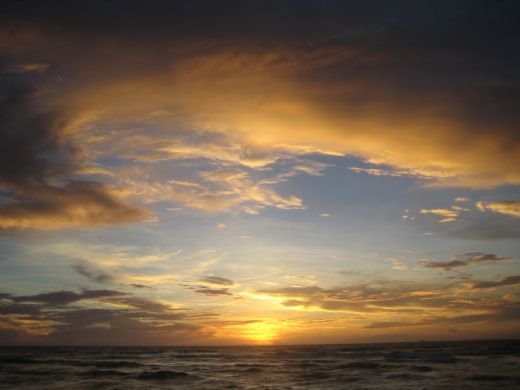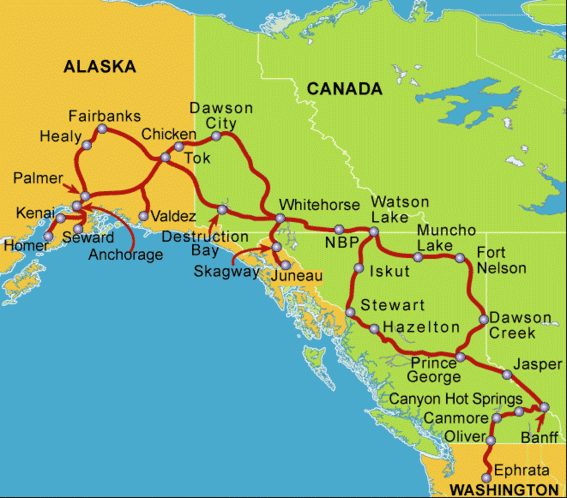We pulled out of Columbia Icefields Visitor’s Center early on a cold gray morning.
The overnight temperature had flirted with 0C but we didn’t worry about freezing the water pipes since we had heat inside the coach and a large mass of water in the tanks.
Icefields Parkway passes several nice waterfalls as it goes north.
We stopped at both
Sunwapta Falls and
Athabasca Falls for pictures and a leg stretch.
We traveled northwest toward the town of Jasper but turned off onto the access road to Jasper Tramway to the top of Whistler Mountain at the 7,496-foot level. The access road was the steepest we’ve seen. We had to climb it in first gear; second just wouldn’t do! At the tram base station, we saw that the mountain was clouded over at the top but decided to go up anyway. The scenery was spectacular during the ascent. We saw many lakes, some clear and others full of glacial silt, the railroad line and a mile-long train laboring west, and the path of the westbound Highway 16, the Yellowhead Highway, that we would be taking to our next destination.
The summit of Whistler Mountain was bathed in a cloud and was getting snow flurries as we exited the tram car. It was COLD up there. We bundled up, went for a short walk around near the summit amid piles of old snow and a light dusting of new powder, then returned to the base. Most of the visitors didn’t stay out long. It was colder and wetter than we had been during our night at Columbia Icefields. The clouds were lifting as we descended but didn’t promise to clear anytime soon. So, we got back in the coach, drove down to the highway and turned west. Leaving the town of Jasper, we passed an RCMP speed trap with a couple of cars and one big rig pulled over in both directions. We were glad that we had been observing the speed limit! Although we’ve seen little police presence on the highways during our travels, this reminded us to be considerate visitors.
The Yellowhead Highway is considered one of Canada’s most scenic routes and lives up to its reputation. It is named for a blonde French trapper of the early 1800’s, nicknamed Tete Jaune, who had a cabin and cache nearby. The route passes out of Alberta at the western boundary of Jasper National Park and enters British Columbia into Mount Robson Provincial Park. Mt. Robson is the tallest peak in the Canadian Rockies at 12,972 feet. The area is a center for rafting and trout fishing. We stopped at the Visitor’s Infocenter at the park to pick up literature on our next destination and to walk the dogs. Missy charmed an entire rafting group who had just been picked up; she got lots of attention and petting from the wet and weary riders and crew.
At the western edge of the park, we detoured several miles south to the northern edge of Valemount for our next stop. Valemount is a town of ~1200 on the plain at the very edge of the mountains, a pretty spot but also an important intersection of several roads across Canada. So, there’s fuel and traveler’s services; these services represent the major economy of the town.
The following morning, we returned to the Yellowhead Highway, passing through the community of Tete Jaune Cache and on to Prince George. The road ran along the Fraser River, through a dense conifer forest, across many creeks and through moose habitat. Sure enough, we saw several moose and even had to stop for one who was planted in the middle of the road at the crest of a small rise. We turned off into a rest area near the Goat River Bridge and found ourselves in a bit of a pickle. The “rest area” single-lane road had a steep downhill grade to a small turnaround. However, the turnaround wasn’t big enough for us with the Suzuki in tow. After starting to turn, and realizing we couldn’t make it around, we had to unhitch the car. This is difficult when on a grade and even more so when the car is turned at a sharp angle to the coach. As a further complication, another motorhome had followed us into the rest area and was now patiently waiting for us to clear the road so they too could turn around and come back up to the picnic tables and rest rooms. After some struggle, we got unhitched, were able to back and fill to get the motorhome turned around, then pulled up and out of the way by the picnic area. We chatted with the other coach’s occupants, a couple and their dog from Alberta, then watched them as they completed the same turn. They weren’t towing a car so got around fine on the first try. It was a gorgeous little spot right next to the river and we lingered for a while to better appreciate the sort of pocket pull-out that we would be more careful to avoid in the future.
After a trip of 184 miles, we arrived in Prince George, BC. This is a surprisingly large industrial city with all the amenities including a Walmart and Costco. We were glad to have services available once more. Missy had wrenched her leg several days earlier and was limping. Her hock was tender and she objected vocally to anyone touching it. We didn’t see much improvement and wanted to have a vet look at her injury. The proprietor of Southpark RV Park graciously called his personal veterinarian, who cares for his prize Chesapeake Bay Retrievers, and made us a drop-in appointment. The animal hospital was short-handed that day but the staff still served us promptly and were very kind and understanding. Missy, luckily, didn’t have a serious injury – just a sprain or stretched ligament rather than the torn ligament that I feared. We left with an anti-inflammatory/painkiller to ease her discomfort. We were in and out with enough time to stop at Costco for a shrimp cocktail tray to take to the caravan’s social hour and travel meeting at 4PM.
Several additional coaches joined us at Prince George for the trip to Alaska. We now have 18 client coaches with 37 guests plus wagon master and tailgunner couples.

